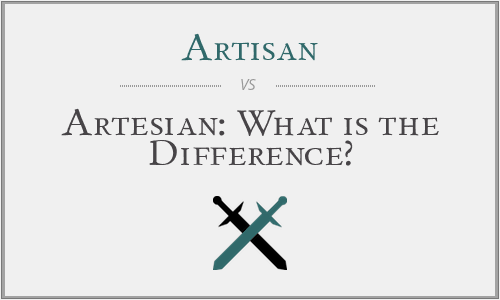
In this article, I will define these two words, “artisan” and “artesian”. You will see that, although the words look similar, they are pronounced differently and defined differently.
Pronouncing the words “Artisan” and “Artesian”
Practice saying these two words aloud, one after the other, hearing the difference between the two pronunciations.
Defining the word “Artisan”
The word artisan is a noun that has been used in the English language since 1530. It is derived from the word artitus (Latin) meaning skilled, and the word artigiano (Italian).
In the Middle Ages, an artisan was someone who was skilled in handmaking objects. Until the Industrial Revolution, many functional commodities were produced by artisans.
Artisans were either masters, having high social status, owning their own businesses, and belonging to guilds; or they were apprentices, working for and learning from the masters.
Today, the word artisan still describes a skilled worker who creates unique, one-of-a-kind merchandise. Artisans are still considered master craftsmen, displaying dexterity and skill. Over time, they might also reach the creative level of an artist.
As such, the items created by an artisan can be both useful as well as decorative. For example, furniture, pottery, mechanisms and tools, clothing, and culinary items are all considered functional, and art and jewelry are decorative.
Examples of artisans include watchmakers, chefs, potters, and jewelry designers; often the line between an artisan and an artist is very thin and a function of creativity and talent.
The word “artisanal” is often used as an adjective to describe an object of high quality that is made in small quantities, usually by hand rather than mass produced.
For example, we now use the terms “artisanal bread” or “artisanal pottery” as well as new-aged terms like “artisanal marketing” or “artisanal advertising,” to imply a more personal style of service.
Defining the word “Artesian”
The word artesian is an adjective and describes a specific type of water found inside an aquifer or a well. Artesian means that a significant amount of positive pressure is being applied to that water from the surrounding walls of rock.
An artesian aquifer contains a specific type of groundwater that is trapped within the confines of the space and rises to the surface due to the natural pressure of the surrounding rock or clay. This successfully eliminates the need to pump the water.
A natural artesian well or a flowing artesian well is a well that is drilled into an artesian aquifer, in which the water has risen to ground level due to natural forces.
Water that is removed from an artesian well is called artesian water, which is marketed and sold successfully in today’s health-conscious, nature-seeking consumer arena.
The phrase artesian well is not new. It comes from the early 1100s where French Carthusian monks were the first discoverers of actual artesian wells.
Final Thoughts
Although the words “artisan” and “artesian” use many of the same letter sequences, we have seen that they do not have the same meaning at all.
It is interesting to note that, in certain instances, the organic movement has fused these two terms together within the context of “sustainable” or “eco-friendly.”
Neither an artisan cuisine nor a bottle of artesian water is guaranteed to safeguard the environment or to be especially healthy for you.




Have a discussion about this article with the community:
Report Comment
We're doing our best to make sure our content is useful, accurate and safe.
If by any chance you spot an inappropriate comment while navigating through our website please use this form to let us know, and we'll take care of it shortly.
Attachment
You need to be logged in to favorite.
Log In